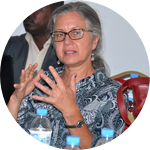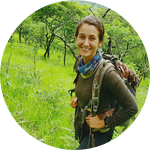About This Project
Eastern Democratic Republic of Congo is home to both highly endangered apes and Batwa and Bantu ethnic groups. It is essential to explore the relationship between culture and apes in order to understand 1) ape presence near communities, 2) communities’ cultural practices, wildlife values systems and natural resource use 3) the relationships between cultural practices, wildlife values resource use and ape presence.
Ask the Scientists
Join The DiscussionWhat is the context of this research?
Eastern Democratic Republic of Cong (DRC) is the only habitat of the critically endangered eastern lowland gorilla (Gorilla beringei graueri) and is also habitat to the largest population of endangered eastern chimpanzee (Pan troglodytes schweinfurthii). Endangered apes are hunted for food and cash income by rural people with limited financial options, are sold for bushmeat (food), for medicinal purposes, and for pets. Apes can trigger negative responses from farmers (e.g., crop-raiding), or can be revered and respected; or a combination of these, depending on the cultural history and livelihood challenges of the community. Thus, the varying ways communities interact with and value primates are complex and shaped by cultural, economic and environmental factors.
What is the significance of this project?
Exploration and analysis is needed about local community traditional practices, the different ways wildlife are valued and the changing dynamics of community and ape relationships and associations.
An exploration of traditional practices and values in select communities, can illuminate the cultural grounding of human-ape associations. Knowledge gained from this project can demonstrate 1) the different ways rural communities value apes in close proximity, 2) how the human-ape dynamic is shaped by cultural practices, 3) if this dynamic has changed over time, and 4) the variation of traditional practices and the ape-human dynamic between villages in the same geographic area.
What are the goals of the project?
I want to understand how communities use the forest in ape habitat and the overlap of humans and apes in this area to mitigate ape decline while also respecting local livelihoods and cultures.
My data collection contains 3 main parts conducted in each of the 3 field sites/villages. First, I will do reconnaissance walks in two sample forest areas to document signs of both humans and apes and will map these signs using GPS to see where apes and humans are present within five km of the village. Second, I will conduct focus group discussions with hunters and cultivators to learn their knowledge of and encounters with apes. Third, I will do semi-structured interviews with traditional leaders to learn the wildlife related traditions and practices.
Budget
This funding will allow me to hire two local Congolese students as researcher assistants and one translator to transcribe interviews which will provide training, experience and money. The funding will also allow me to hire drivers to get me to the research sites safely.
I have some personal funding that will help me pay for airfare and visas and some equipment. I am so waiting for a couple small research grants.
Endorsed by
 Project Timeline
Project Timeline
I arrived to DRC the beginning of June to meet with colleagues and assess exact site locations (4) and arrange research assistants.
July: Data collection completed in the first site. Preparing for 2nd site data collection.
End of July: Data collection 2nd site
August: Data collection 3rd Site
September: Data collection 4th site and follow up of other sites.
October: Arrange workshops and presentations on preliminary findings.
Jun 07, 2021
Travel to Bukavu, Democratic Republic of Congo
Jun 14, 2021
Assess site locations
Jun 21, 2021
Arrange research assistants
Jul 01, 2021
1st Site Data collection
Jul 13, 2021
Project Launched
Meet the Team
Affiliates
Team Bio
My research committee includes: Dr. Beth Kaplin, Acting Director of the Center of Excellence, Univ of Rwanda, Dr. Augustin Basabose the Director of Primate Expertise, Dr. Carolyn Jost Robinson, Director of Sociocultural Research Chengela Wildlife, Dr. Liz Willey, faculty Environmental Studies, Antioch Univ New England. My local Congolese research assistant are Rodrigue Batumike and John Kalume who have extensive field experience in the South Kivu area and have published.
Mary Jo Austin
Ever since my first Anthropology course I became fascinated with primates. Once learning that most primate populations are in jeopardy I was inspired to get involved and learn more. Now, after several years of volunteering, doing fieldwork, and many college courses, I am a PhD candidate preparing for another field research project to learn about rural communities and their ape neighbors in the Democratic Republic of Congo (DRC).
I am very concerned about the chimpanzees and gorillas in eastern DRC because their populations are declining so rapidly. They are targets for hunters for meat and are also taken from the wild and sold as pets. Their habitat is also shrinking from large scale industrial agriculture and mining. Often the rural communities living near apes are also vulnerable and do not have many options to make money and are often restricted from land and resources they depend on. The relationship of rural communities, apes and resources is a complicated dilemma that I have sought to learn more about. The perspective, values and knowledge of communities living near ape habitat, I believe, should be brought to the forefront in conservation efforts and assessments.
I have an undergraduate degree in Anthropology, a MSc in Resource Management and a MSc in Environmental Studies. I have done ape related fieldwork in Cameroon and Gabon. In addition I have worked in Rwanda assisting my advisor Dr. Beth Kaplin at the Center of Excellence under the University of Rwanda and in eastern DRC working with a Congolese organization Strong Roots Congo. Here, I had the opportunity to visit remote villages and meet with several people working in conservation in the area including NGO staff, university professors and students. Spending time in the area was very instrumental in preparing for my project.
Additional Information
Due to conflict and the exploitation of land for mining and agriculture, apes and local communities have faced challenges to survive. Consequently, conservation efforts and initiatives for local livelihood improvements are crucial. Managers in the protected areas in this region continue to monitor for illegal activity and conduct biological assessments. Funding to maintain these activities is tenuous. Also, there are many rare species such as chimpanzees and gorillas living outside of the protected areas that are vulnerable to threats but do not have the same protections. There are many communities living on the edges of Kahuzi-Biega National Park and Itombwe Nature Reserve including Bantu and the indigenous Batwa groups who, to some extent, still rely on forest resources. People living in and around Itombwe Nature Reserve are also dependent on forest resources.
Project Backers
- 20Backers
- 108%Funded
- $3,792Total Donations
- $189.60Average Donation


